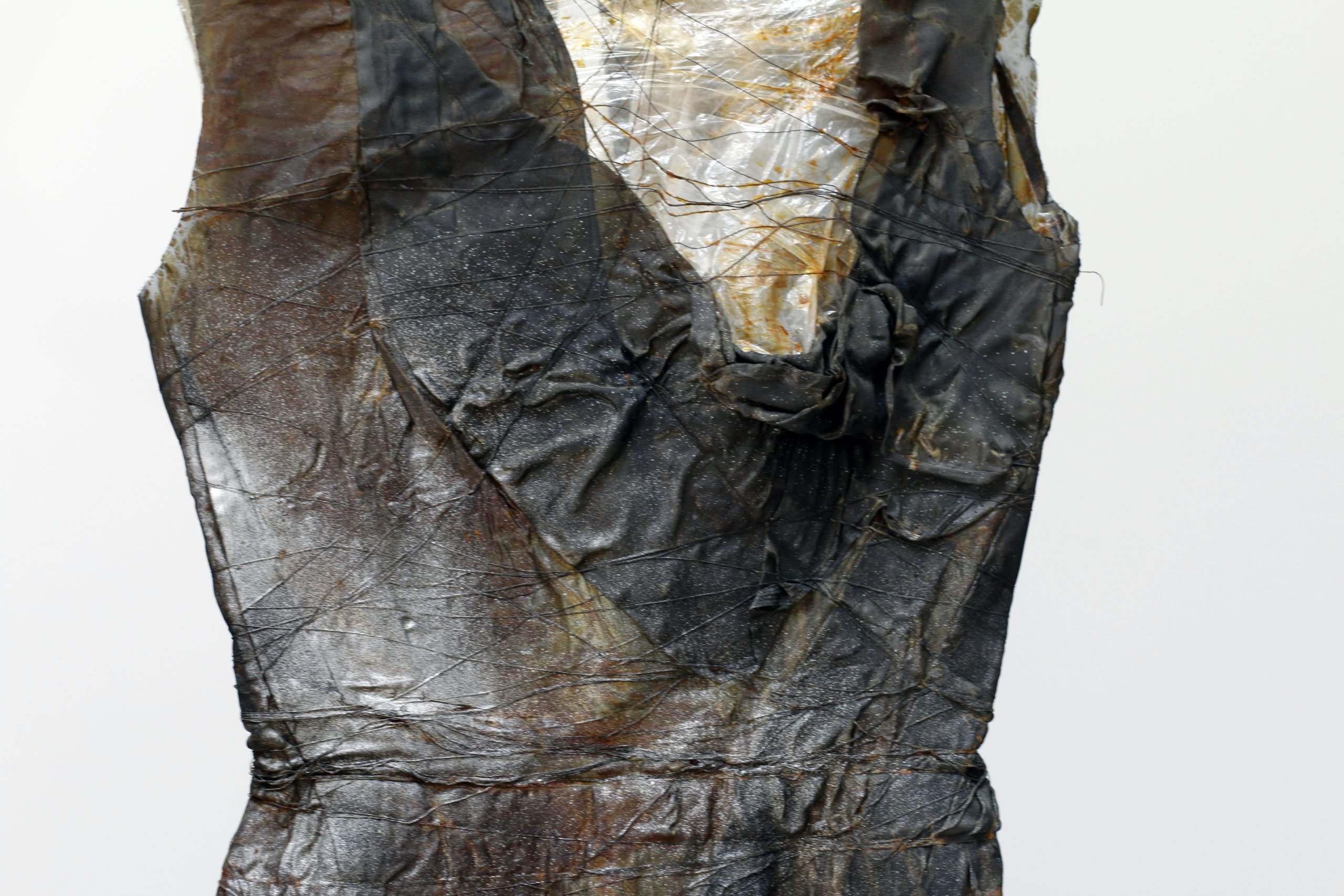As Barrett Barrera Projects staff have been working closely with objects in the collection to develop our latest exhibitions, they’ve picked their favorites to share with you! View their selections and learn more about some of the pieces featured in Ann Ray & Lee McQueen: Rendez-Vous and Introducing Lee Alexander McQueen.
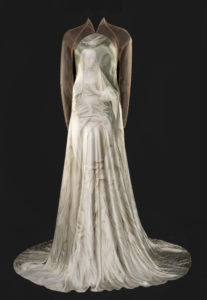 Susan Barrett, President
Susan Barrett, President
Alexander McQueen, Gown with Virgin Mary Digital Print, Autumn/Winter 2010
I chose this gown because of the rarity of the garment & eventual premonition of McQueen’s death. It’s beautiful & ethereal, yet haunting. Because women were so important to Lee and so dominant in his life, I like the symbolism of using the only female deity in Christianity: She is a paradox of Virgin and mother: A classic juxtaposition in the patriarchal understanding of women. I also resonate with it because of my upbringing in a Mexican Catholic family: Mary is the most important figure and yet the most compassionate & approachable.
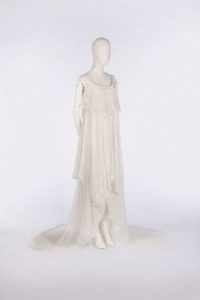 Kelly Peck, Vice President
Kelly Peck, Vice President
Alexander McQueen, Creme Tulle Gown, Autumn/Winter 2008
Barrett Barrera Projects curates and manages one of the world’s largest private collections of Alexander McQueen work. I began research to support the collection and related exhibitions in 2012 and one of my favorite seasons from McQueen has always been the Fall/Winter 2008 presentation of The Girl Who Lived in the Tree. The designer explained, “I’ve got a 600-year-old elm tree in my garden and I made up this story of a girl who lives in it and comes out of the darkness to meet a prince and become a queen”. To me, storytelling is such a strong component of the human experience and this work exemplifies McQueen’s mastery in crafting narrative.
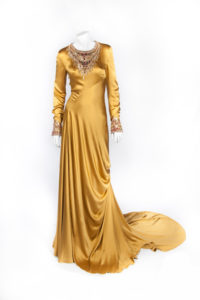 Bridget Melloy, Senior Director, projects+gallery
Bridget Melloy, Senior Director, projects+gallery
Alexander McQueen, Gold Gown with Beading, Autumn/Winter 2010
I have always been drawn to this beautiful satin gown. The silhouette looks simple enough, but once you get a closer look at the garment you are able to see McQueen’s complicated seems that cut across the body diagonally to achieve a graceful cut of the gown. The carefully hidden zippers and intricate beadwork show the meticulous and innovative design details of his work to create a stunning garment.
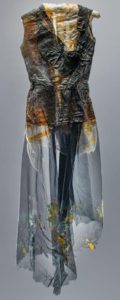 Jessica Baran, Director of Curatorial & Program Development
Jessica Baran, Director of Curatorial & Program Development
Alexander McQueen, Asymmetrical deconstructed torso dress, using plastic wrap, resin and auto spray paint, Autumn/Winter 1995
According to friends’ accounts, McQueen — an avid club-goer and fan of iconic performance artist Leigh Bowery — once wrapped himself in cellophane before going out for a night of revelry. Not long after, he came across a roll of cellophane tossed on the street and declared that he should make a dress out of it. So he did: that dress appeared in his S/S 1995 collection “The Birds.” Cellophane then made a reappearance in this dress, from his A/W 1995 collection “Highland Rape.” I love the immediacy of this story and how it and this garment provide a glimpse into McQueen’s early career — cash-strapped, intuitive, unconcerned with the restrictions of the market and status-quo respectability. It’s also lovely how this everyday, kitchen-drawer material, despite being transformed into a garment, still manages to behave as precisely what it is: a preservative. With it, McQueen remains connected to his roots in DIY anti-fashion and queer club culture, before that rawer identity became subsumed by the brand.
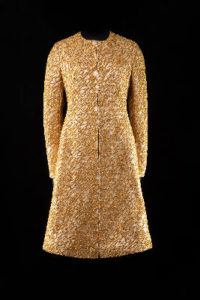 Claire Grothe, Research & Systems Manager
Claire Grothe, Research & Systems Manager
Alexander McQueen, Embroidered “Annabel Lee” Poem Coat, Autumn/Winter 2008
This beautiful coat is embroidered with the Edgar Allen Poe poem “Annabel Lee” as a tribute to his good friend Annabelle Neilson. Not only do I love the tailoring and embroidery from an aesthetic perspective, but the personal touch gives a glimpse into the enigmatic McQueen’s relationships with his inner circle.
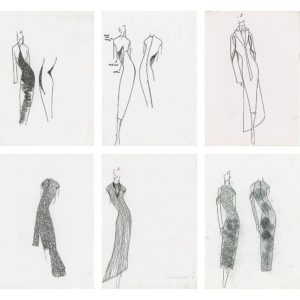 Eric Repice, Preparator
Eric Repice, Preparator
Alexander McQueen, Sketchbook with 36 original design drawings, c.1995
My favorite part of Introducing Lee Alexander McQueen is getting to see the artist’s sketchbooks. I like learning more about how these beautiful pieces emerged from his hand, eye, and mind.
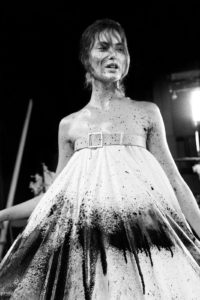 Margaret Sherer, Associate Curator, projects+gallery
Margaret Sherer, Associate Curator, projects+gallery
Ann Ray, Insensé II, 1998, Archival gelatin silver print from original negatives
This photograph was taken after the finale of Alexander McQueen’s Spring 1999 runway show, No. 13, during which model Shalom Harlow emerged onto the stage on a revolving wooden platform wearing a virginal white dress with a tulle underlay that was at once delicate and engulfing. As Harlow began slowly spinning like a jewelry box ballerina on the platform, two large robot arms menacingly pointed in her direction and began spraying her with black, green and yellow paint. Video of this climactic, performative, emotional runway moment was one of the first experiences I had of McQueen’s work and I was completely captivated. Ann Ray’s photograph potently expresses the catharsis of that moment after the spray has subsided–a situation all too real and even dangerous for Harlow, while deeply enthralling for the audience. Ray’s photograph is not only a record of this singular performance, but vividly encapsulates the raw, dark and beautiful ethos of McQueen.
